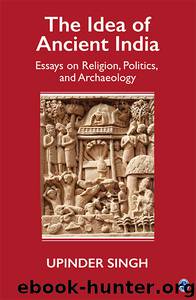The Idea of Ancient India by Upinder Singh

Author:Upinder Singh [Singh, Upinder]
Language: eng
Format: epub
ISBN: 9789351506461
Publisher: SAGE Publications
Published: 2009-09-09T08:51:49+00:00
8
Exile and Return:
The Reinvention
of Buddhism and
Buddhist Sites in
Modern India*
A great deal of scholarly attention has been bestowed on the early history of Buddhism in the Indian subcontinent, but the understanding of its longer-term trajectories is very inadequate. The general view is that Buddhism declined drastically during the early medieval period (c. 600–1200 ce). However, there are grounds for arguing that the hypothesis of a virtual extinction of Buddhism during that period is at least in part the result of a lack of investigation and the non-acknowledgement of textual, epigraphic, and archaeological evidence that suggests otherwise.1
Eastern India is often seen as the last Buddhist bastion, where monasteries such as those of Nālandā, Odantapura, Vikramaśilā, and Somapurī flourished under the patronage of the Pāla kings.2 But there is evidence from other regions as well. In Orissa, remains of early medieval stūpas, monasteries, and sculptures are known from Lalitagiri and Ratnagiri. Many Buddhist vihāras were built during this period in Nepal. The Chachnāmā, an early 13th century Persian translation of an old Arabic history of Muhammad bin Qasim’s conquest of Sind in the early 8th century, suggests that Buddhism was an important part of the religious landscape of this north-western region. In Kashmir, the Ratnagupta and Ratnaraśmī monasteries at Anupamapura flourished in the 11th and 12th centuries. Several major ancient Buddhist monastic centres—for instance those at Sanchi (in modern Madhya Pradesh), Amaravati (in Andhra Pradesh), and Nalanda (in Bihar)—continued to flourish until the 12th to 13th centuries. Even after the 13th century, the monastic tradition was alive in the western Himalayas in Ladakh, Lahaul, and Spiti, which had close connections with the monasteries of Tibet. In fact, some of these monasteries have a more or less continuous history from the early medieval period right down to the present. It is clear that Buddhism never really disappeared from India, though it did decline, and was relegated to the geographical, political, and cultural margins.
Just as problematic as the assessments of the extent of Buddhism’s decline are the explanations for this decline. While the Turks have been blamed for the sack of Nālandā at the close of the 12th century, they were certainly not responsible for the demise of monasteries in other parts of the country. Apart from the Turks, the most frequently cited reasons for the religion’s decline include its being swallowed up by Hinduism due to its lack of distinctiveness, the ‘open frontier’ between Buddhism and local cults, ‘corruption’ by Tāntric influences, a decline in political patronage, and the saṅgha’s loss of material support due to economic dislocation caused by frequent wars.3
There is a view that Buddhism’s eclipse was never complete, and that there was a connection between its lingering, simmering ancient residue and the Buddhist resurgence in modern India. For instance, Benoy Gopal Ray has argued that a handful of Buddhists survived in Bengal after the religion had virtually disappeared in other parts of the subcontinent, and that this spark was re-ignited by Buddhist revivalist movements in the late 19th century.4 Similarly, there
Download
This site does not store any files on its server. We only index and link to content provided by other sites. Please contact the content providers to delete copyright contents if any and email us, we'll remove relevant links or contents immediately.
| Africa | Americas |
| Arctic & Antarctica | Asia |
| Australia & Oceania | Europe |
| Middle East | Russia |
| United States | World |
| Ancient Civilizations | Military |
| Historical Study & Educational Resources |
Goodbye Paradise(3726)
Men at Arms by Terry Pratchett(2782)
Tobruk by Peter Fitzsimons(2443)
Arabs by Eugene Rogan(2260)
Borders by unknow(2227)
Pirate Alley by Terry McKnight(2181)
Belonging by Unknown(1805)
It's Our Turn to Eat by Michela Wrong(1683)
The Biafra Story by Frederick Forsyth(1616)
Botswana--Culture Smart! by Michael Main(1559)
The Source by James A. Michener(1535)
A Winter in Arabia by Freya Stark(1502)
Coffee: From Bean to Barista by Robert W. Thurston(1487)
The Falls by Unknown(1485)
Gandhi by Ramachandra Guha(1485)
Livingstone by Tim Jeal(1450)
The Shield and The Sword by Ernle Bradford(1366)
Africa: Altered States, Ordinary Miracles by Richard Dowden(1350)
Egyptian Mythology A Fascinating Guide to Understanding the Gods, Goddesses, Monsters, and Mortals (Greek Mythology - Norse Mythology - Egyptian Mythology) by Matt Clayton(1327)
